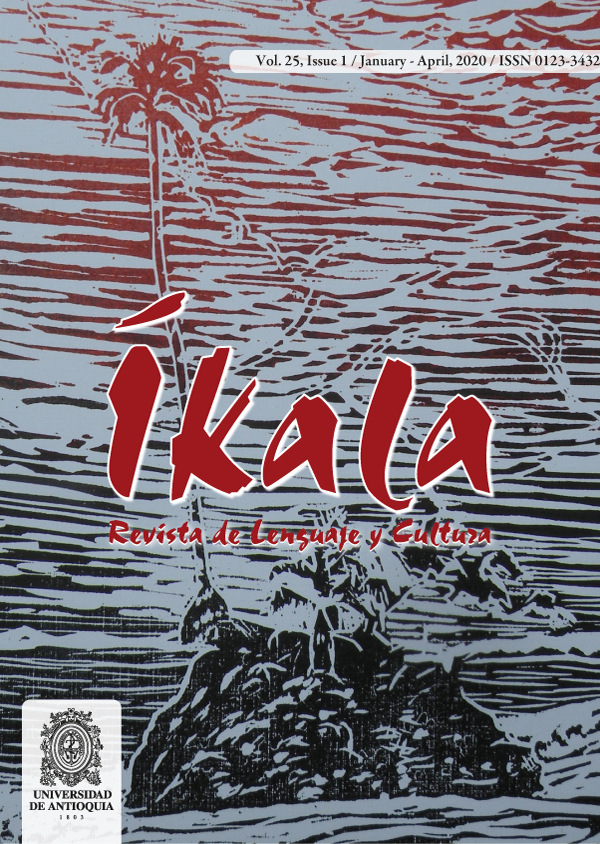Transmutação texto-ilustração: um modelo para a análise de seu efeito sobre as dinâmicas e funções dos livros infantis
DOI:
https://doi.org/10.17533/udea.ikala.v25n01a08Palavras-chave:
álbum ilustrado, dinâmicas texto-ilustração, literatura infantil, teoria da traduçãoResumo
Este artigo procura aplicar certos fundamentos da teoria da tradução na análise de álbuns ilustrados. Com tal fim, apresenta um modelo de análise para o estudo das transmutações entre texto e ilustração nos livros infantis, dividido em três etapas. Na primeira, determina-se a informação que o elemento visual (desenho) traslada, acrescenta, modifica ou omite em relação ao elemento verbal (texto), a partir da identificação de diferentes estratégias e procedimentos próprios da tradução. Na segunda etapa, aplicam-se esses resultados ao estudo das dinâmicas entre texto e ilustração, procurando estabelecer qual mensagem acaba transmitindo ao leitor a confluência entre esses dois elementos. Na terceira, identificam-se várias das funções tradicionalmente associadas à literatura infantil, para avaliar até que ponto a inter-relação entre o texto e a ilustração as enfatiza ou eclipsa. Para exemplificar o modelo de análise anterior estudam-se diferentes passagens e ilustrações do livro de Marla Frazze, A Couple of Boys Have the Best
Downloads
Referências
- Anderson, N. A. (2002). Elementary children's literature: The basics for teachers and parents. Boston: Allyn and Bacon.
-Barone, D.M. (2011). Children´s literature in the classroom: Engaging lifelong readers. Nueva York; Londres: The Guilford Press.
- Campos, H. (1992). Metalinguagem & Outras Metas. São Paulo: Perspectiva.
- Eco, U. (2008) Decir casi lo mismo. Barcelona: Lumen.
- Frazee, M. (2008). A Couple of Boys Have the Best Week Ever. Orlando: Harcourt, Inc.
- Hunt, P. (2001). Children’s literature. Oxford; Maden: Blackwell Publishers.
- Hurtado Albir, A. (2001). Traducción y traductología, introducción a la traductología. Madrid: Cátedra.
- Jakobson, R. (1959/2000): On Linguistic Aspects of Translation. In L. Venuti, (ed.) The Translation Studies Reader, (pp. 113-118). Londres; Nueva York: Routledge.
- Nikolajeva, M. y Scott, C. (2001). How Picturebooks Work. Nueva York; Londres: Garland Publishing.
- Pereira, N. M. (2007). Book Illustration as Intersemiotic Translation: The Case of Alice in Wonderland in Brazil. In D. Kenny and K. Ryou (eds.), Across Boundaries: International Perspectives on Translation Studies, (pp. 56-77). Newcastle: Cambridge Scholars Publishing.
- Pereira, N. M. (2008). Book Illustration as (Intersemiotic) Translation: Pictures translating words. Meta, 53(1), 104-119. doi:10.7202/017977ar
- Salehipour, M. y Tabatabaei Lotfi, N. (2016). From Poem to Painting: An Aspect of Intersemiotic Translation, a Case Study of Rustum and Sohrab Story. Theory and Practice in Language Studies, 6 (10), 2007. doi:10.17507/tpls.0610.17
- Salmani, B. y Eghtesadi, Z. (2015). An Intersemiotic Approach Towards Translation of Cover Designs in Retranslated Classic Novels. Theory and Practice in Language Studies, 5(6), 1185. doi:10.17507/tpls.0506.09
- Schwarcz, J. H. (1982). Ways of the Illustrator: Visual Communication in Children’s Literature. Chicago: American Library Association.
- Serafini, F., & Moses, L. (2014). The roles of children's literature in the primary grades. The Reading Teacher, 67(6), 465-468
- Sipe, L. R. (1998). How picture books work: A semiotically framed theory of
text-picture relationships Children’s Literature in Education, 29(2),
–108.
- Sitzia, E. (2010). ‘Where is the Prince?’ Unlocking Doré’s Illustration of Perrault’s Cinderella. Relief: Revue Électronique De Littérature Francaise, 4(2), 158-173. doi:10.18352/relief.543
- Vinay, J. P., and Darbelnet, J. (1995). Comparative Stylistics of French and English: A Methodology for Translation. Amsterdam; Filadelfia: John Benjamins.
Publicado
Como Citar
Licença
Copyright (c) 2020 Íkala, Revista de Lenguaje y Cultura

Este trabalho está licenciado sob uma licença Creative Commons Attribution-NonCommercial-ShareAlike 4.0 International License.












